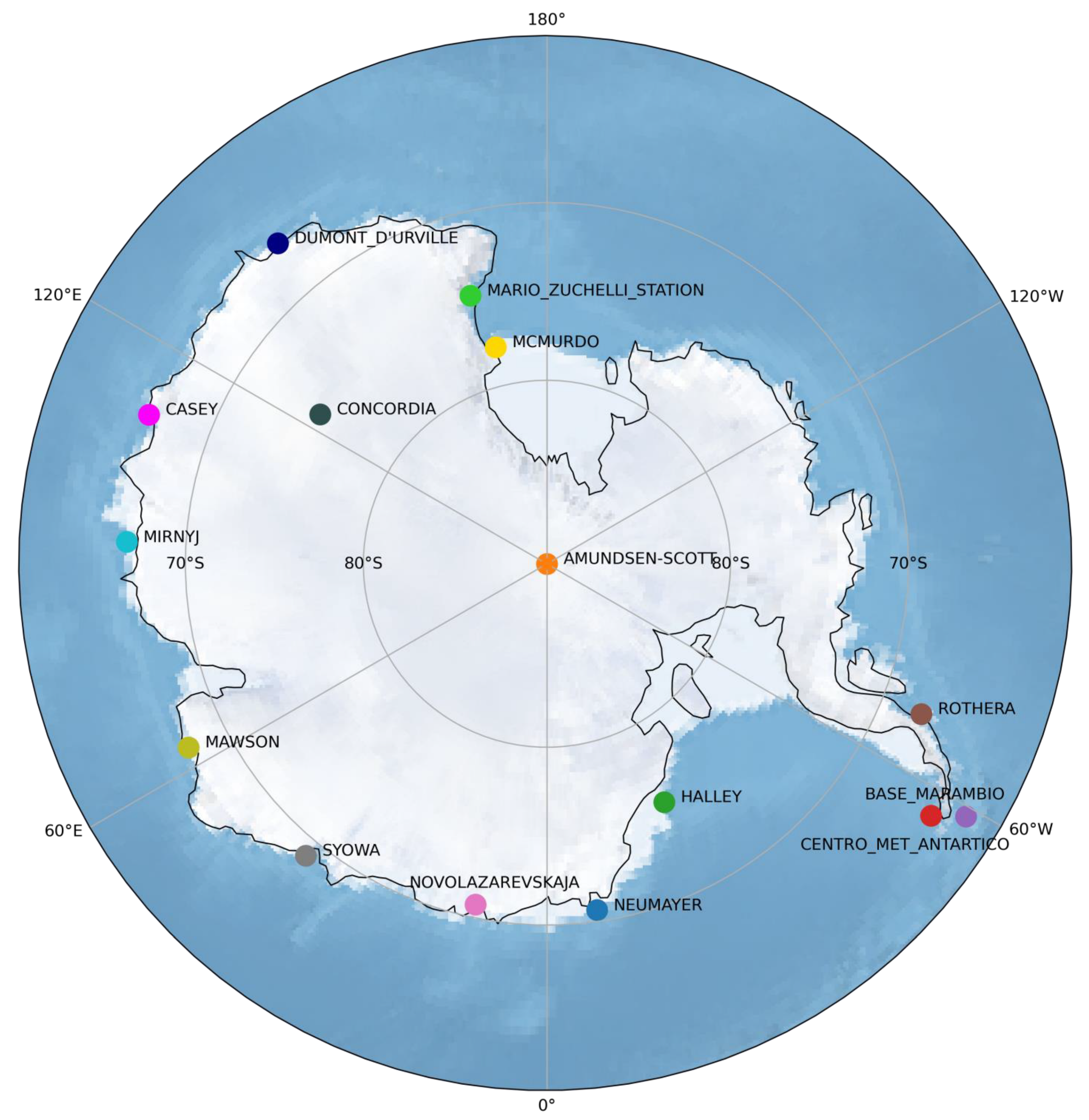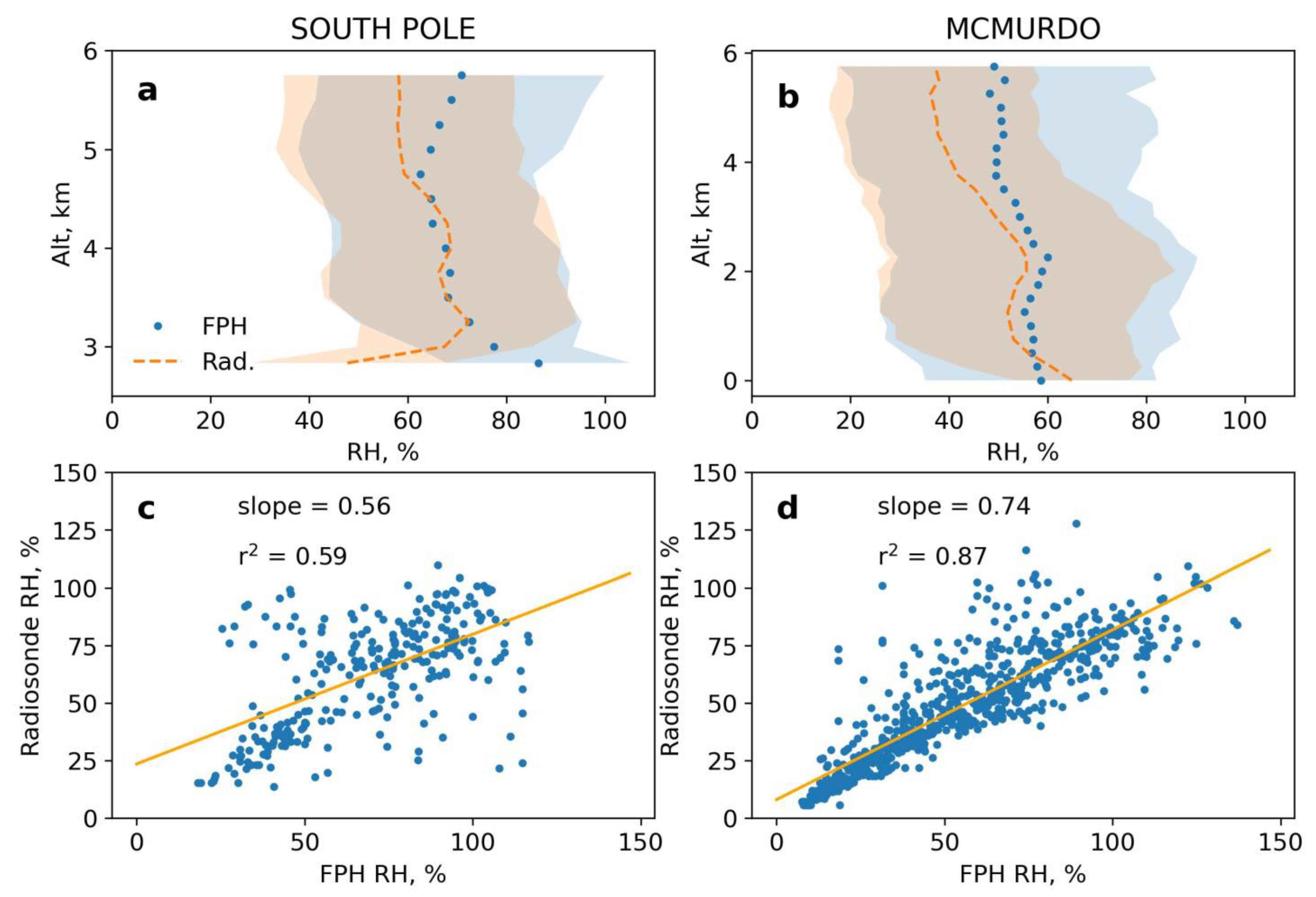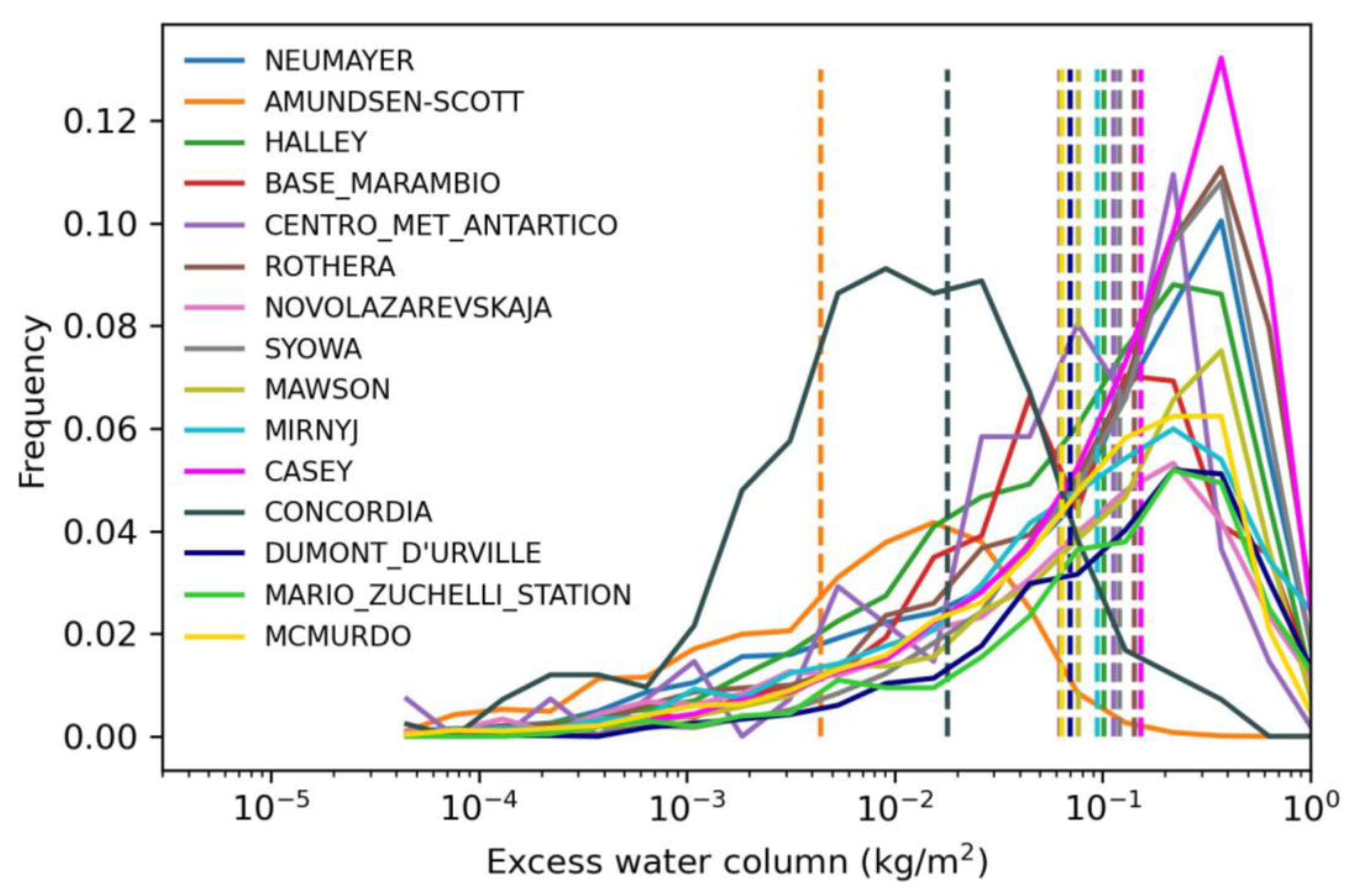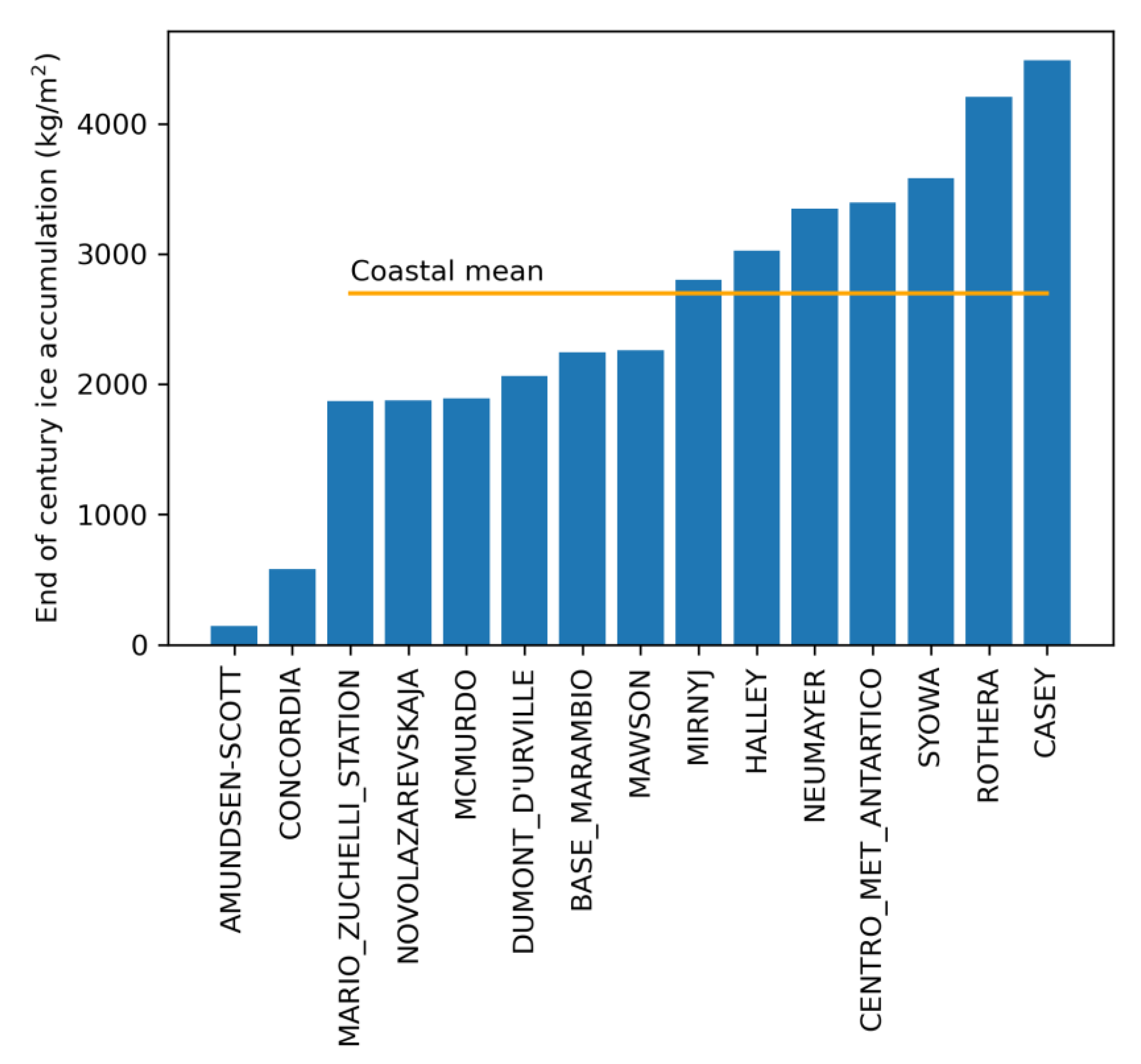Increasing Antarctic Ice Mass to Help Offset Sea Level Rise
Abstract
:1. Introduction
2. Materials and Methods
2.1. Liquid Water Availability
2.2. Excess Water Vapor over Antarctica
| Log10 es = −7.90298 (373.16/T − 1) + 5.02808 Log10(373.16/T) − 1.3816 × 10−7 (1011.344 (1−T/373.16) − 1) + 8.1328 × 10−3 (10−3.49149 (373.16/T−1) − 1) + Log10(1013.246) | (1) |
| Log10 esi = −9.09718 (273.16/T − 1) − 3.56654 Log10(273.16/T) + 0.876793 (1 − T/273.16) + Log10(6.1071) | (2) |
3. Results
4. Discussion
5. Conclusions
Author Contributions
Funding
Institutional Review Board Statement
Informed Consent Statement
Data Availability Statement
Acknowledgments
Conflicts of Interest
References
- Hermans, T.H.J.; Gregory, J.M.; Palmer, M.D.; Ringer, M.A.; Katsman, C.A.; Slangen, A.B.A. Projecting Global Mean Sea-Level Change Using CMIP6 Models. Geophys. Res. Lett. 2021, 48, e2020GL092064. [Google Scholar] [CrossRef]
- Horton, B.P.; Khan, N.S.; Cahill, N.; Lee, J.S.H.; Shaw, T.A.; Garner, A.J.; Kemp, A.C.; Engelhart, S.E.; Rahmstorf, S. Estimating global mean sea-level rise and its uncertainties by 2100 and 2300 from an expert survey. NPJ Clim. Atmos. Sci. 2020, 3, 18. [Google Scholar] [CrossRef]
- NOAA. 2022 Sea Level Rise Technical Report. Section 2. 2022. Available online: https://aambpublicoceanservice.blob.core.windows.net/oceanserviceprod/hazards/sealevelrise/2.0-Future-Mean-Sea-Level.pdf (accessed on 13 October 2023).
- Lockley, A.; Wolovick, M.; Keefer, B.; Gladstone, R.; Zhao, L.-Y.; Moore, J.C. Glacier geoengineering to address sea-level rise: A geotechnical approach. Adv. Clim. Change Res. 2020, 11, 401–414. [Google Scholar] [CrossRef]
- CIA. Antarctica. 2023. Available online: https://www.cia.gov/the-world-factbook/countries/antarctica/ (accessed on 13 October 2023).
- NOAA. 2023. Available online: https://oceanexplorer.noaa.gov/facts/explored.html#:~:text=Consider%20the%20size%20of%20the,3%2C682%20meters%20(12%2C080%20feet) (accessed on 13 October 2023).
- Frieler, K.; Mengel, M.; Levermann, A. Delaying future sea-level rise by storing water in Antarctica. Earth Syst. Dyn. 2016, 7, 203–210. [Google Scholar] [CrossRef]
- Boyer, S.; Lefort, M.C. Sequestering seawater on land: A water-based solution to global issues [version 2; peer review: 2 approved with reservations, 1 not approved]. F1000Research 2017, 5, 889. [Google Scholar] [CrossRef]
- Davison, B.J.; Hogg, A.E.; Rigby, R.; Veldhuijsen, S.; van Wessem, J.M.; van den Broeke, M.R.; Holland, P.R.; Selley, H.L.; Dutrieux, P. Sea level rise from West Antarctic mass loss significantly modified by large snowfall anomalies. Nat. Commun. 2023, 14, 1479. [Google Scholar] [CrossRef] [PubMed]
- Lawson, R.P.; Gettelman, A. Impact of Antarctic mixed-phase clouds on climate. Proc. Natl. Acad. Sci. USA 2014, 111, 18156–18161. [Google Scholar] [CrossRef]
- Ricaud, P.; Del Guasta, M.; Bazile, E.; Azouz, N.; Lupi, A.; Durand, P.; Attié, J.-L.; Veron, D.; Guidard, V.; Grigioni, P. Supercooled liquid water cloud observed, analysed, and modelled at the top of the planetary boundary layer above Dome C, Antarctica. Atmos. Chem. Phys. 2020, 20, 4167–4191. [Google Scholar] [CrossRef]
- Silber, I.; Fridlind, A.M.; Verlinde, J.; Ackerman, A.S.; Chen, Y.; Bromwich, D.H.; Wang, S.; Cadeddu, M.; Eloranta, E.W. Persistent Supercooled Drizzle at Temperatures Below −25 °C Observed at McMurdo Station, Antarctica. J. Geophys. Res. Atmos. 2019, 124, 10878–10895. [Google Scholar] [CrossRef]
- Listowski, C.; Delanoë, J.; Kirchgaessner, A.; Lachlan-Cope, T.; King, J. Antarctic clouds, supercooled liquid water and mixed phase, investigated with DARDAR: Geographical and seasonal variations. Atmos. Chem. Phys. 2019, 19, 6771–6808. [Google Scholar] [CrossRef]
- Goff, J.A.; Gratch, S. Low-pressure properties of water from −160 to 212 F. Trans. Am. Soc. Heat. Vent. Eng. 1946, 95–122. [Google Scholar]
- Smithsonian Meteorological Tables, 5th ed.; Smithsonian Institute Press: Washington, DC, USA, 1984; p. 350.
- Dirksen, R.J.; Sommer, M.; Immler, F.J.; Hurst, D.F.; Kivi, R.; Vömel, H. Reference quality upper-air measurements: GRUAN data processing for the Vaisala RS92 radiosonde. Atmos. Meas. Tech. 2014, 7, 4463–4490. [Google Scholar] [CrossRef]
- Miloshevich, L.M.; Vömel, H.; Paukkunen, A.; Heymsfield, A.J.; Oltmans, S.J. Characterization and Correction of Relative Humidity Measurements from Vaisala RS80-A Radiosondes at Cold Temperatures. J. Atmos. Ocean. Technol. 2001, 18, 135–156. [Google Scholar] [CrossRef]
- Wang, J.; Cole, H.L.; Carlson, D.J.; Miller, E.R.; Beierle, K.; Paukkunen, A.; Laine, T.K. Corrections of Humidity Measurement Errors from the Vaisala RS80 Radiosonde—Application to TOGA COARE Data. J. Atmos. Ocean. Technol. 2002, 19, 981–1002. [Google Scholar] [CrossRef]
- Monaghan, A.J.; Bromwich, D.H.; Powers, J.G.; Manning, K.W. The Climate of the McMurdo, Antarctica, Region as Represented by One Year of Forecasts from the Antarctic Mesoscale Prediction System. J. Clim. 2005, 18, 1174–1189. [Google Scholar] [CrossRef]
- Wright, D.M.; Posselt, D.J.; Steiner, A.L. Sensitivity of lake-effect snowfall to lake ice cover and temperature in the Great Lakes region. Mon. Weather. Rev. 2013, 141, 670–689. [Google Scholar] [CrossRef]
- Brown, S.; Nicholls, R.J.; Goodwin, P.; Haigh, I.D.; Lincke, D.; Vafeidis, A.T.; Hinkel, J. Quantifying Land and People Exposed to Sea-Level Rise with no Mitigation and 1.5 °C and 2.0 °C Rise in Global Temperatures to Year 2300. Earth's Future 2018, 6, 583–600. [Google Scholar] [CrossRef]
- Douville, H.; Qasmi, S.; Ribes, A.; Bock, O. Global warming at near-constant tropospheric relative humidity is supported by observations. Commun. Earth Environ. 2022, 3, 237. [Google Scholar] [CrossRef]
- IPCC. 2021 Climate Change 2021: The Physical Science Basis; Masson-Delmotte, V., Zhai, P., Pirani, A., Connors, S.L., Péan, C., Berger, S., Caud, N., Chen, Y., Goldfarb, L., Gomis, M.I., et al., Eds.; Contribution of Working Group I to the Sixth Assessment Report of the Intergovernmental Panel on Climate Change; Cambridge University Press: Cambridge, UK; New York, NY, USA, 2021; in press. [Google Scholar] [CrossRef]
- Schaefer, V.J. The production of ice crystals in a cloud of supercooled water droplets. Science 1946, 104, 457–459. [Google Scholar] [CrossRef]
- Vonnegut, B. The nucleation of ice formation by silver iodide. J. Appl. Phys. 1947, 18, 593–595. [Google Scholar] [CrossRef]
- French, J.R.; Friedrich, K.; Tessendorf, S.A.; Rauber, R.M.; Geerts, B.; Rasmussen, R.M.; Xue, L.; Kunkel, M.L.; Blestrud, D.R. Precipitation formation from orographic cloud seeding. Proc. Natl. Acad. Sci. USA 2018, 115, 1168–1173. [Google Scholar] [CrossRef] [PubMed]
- Tessendorf, S.A.; French, J.R.; Friedrich, K.; Geerts, B.; Rauber, R.M.; Rasmussen, R.M.; Xue, L.; Ikeda, K.; Blestrud, D.R.; Kunkel, M.L.; et al. A transformational approach to winter orographic weather modification research: The SNOWIE project. Bull. Am. Meteorol. Soc. 2019, 100, 71–92. [Google Scholar] [CrossRef]




| Frequency of Vapor Removal | EoC Excess Water (kg/m2) | EoC Excess Water with Dry Bias Correction (kg/m2) | EoC Cloud Liquid Water Removed (kg/m2) | EoC SLR Offset (cm) | EoC SLR Offset with Dry Bias Correction (cm) | EoC Cloud SLR Offset (cm) |
|---|---|---|---|---|---|---|
| Daily | 2700 | 10,800 | 570 | 2.6 | 10.4 | 0.6 |
| Weekly | 390 | 1540 | 570 | 0.37 | 1.5 | 0.6 |
Disclaimer/Publisher’s Note: The statements, opinions and data contained in all publications are solely those of the individual author(s) and contributor(s) and not of MDPI and/or the editor(s). MDPI and/or the editor(s) disclaim responsibility for any injury to people or property resulting from any ideas, methods, instructions or products referred to in the content. |
© 2023 by the authors. Licensee MDPI, Basel, Switzerland. This article is an open access article distributed under the terms and conditions of the Creative Commons Attribution (CC BY) license (https://creativecommons.org/licenses/by/4.0/).
Share and Cite
Larson, E.J.L.; Rosenlof, K.H.; Gao, R.-S. Increasing Antarctic Ice Mass to Help Offset Sea Level Rise. Atmosphere 2023, 14, 1564. https://doi.org/10.3390/atmos14101564
Larson EJL, Rosenlof KH, Gao R-S. Increasing Antarctic Ice Mass to Help Offset Sea Level Rise. Atmosphere. 2023; 14(10):1564. https://doi.org/10.3390/atmos14101564
Chicago/Turabian StyleLarson, Erik J. L., Karen H. Rosenlof, and Ru-Shan Gao. 2023. "Increasing Antarctic Ice Mass to Help Offset Sea Level Rise" Atmosphere 14, no. 10: 1564. https://doi.org/10.3390/atmos14101564
APA StyleLarson, E. J. L., Rosenlof, K. H., & Gao, R.-S. (2023). Increasing Antarctic Ice Mass to Help Offset Sea Level Rise. Atmosphere, 14(10), 1564. https://doi.org/10.3390/atmos14101564





